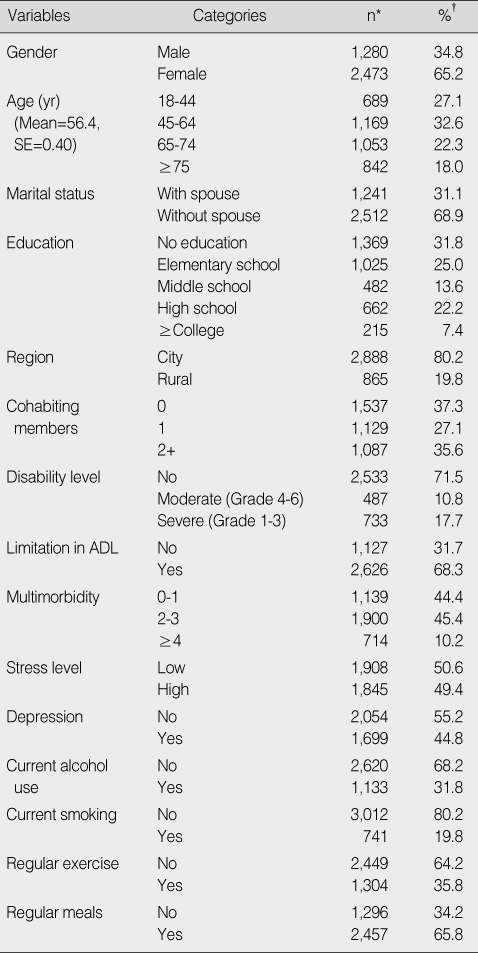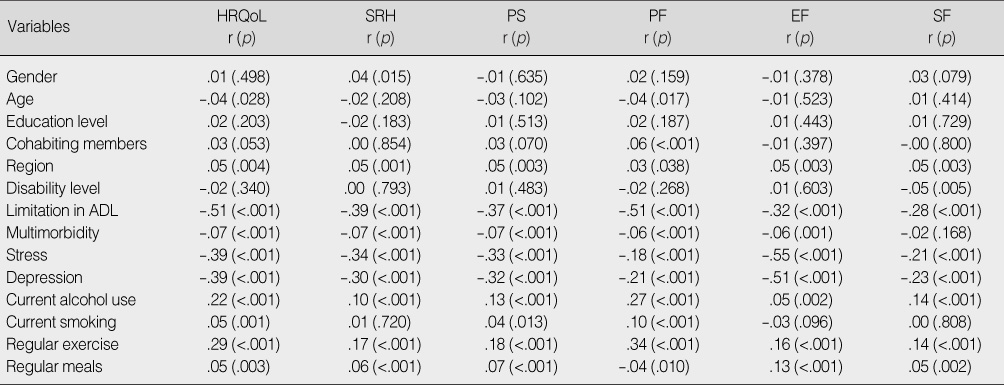Articles
- Page Path
- HOME > J Korean Acad Nurs > Volume 39(4); 2009 > Article
-
Original Article
- Factors influencing Health-related Quality of Life in Korean Medicaid Beneficiaries
- Sun-Woo Hong
-
Journal of Korean Academy of Nursing 2009;39(4):480-489.
DOI: https://doi.org/10.4040/jkan.2009.39.4.480
Published online: August 31, 2009
Part-time Lecturer, College of Nursing, Kangwon National University, Chuncheon, Korea.
- Address reprint requests to: Hong, Sun-Woo. College of Nursing, Kangwon National University, Hyoja 2-dong, Chuncheon 200-701, Korea. Tel: 82-10-2084-7208, Fax: 82-33-242-8840, swhongks77@freechal.com
Copyright © 2009 Korean Society of Nursing Science
Abstract
-
Purpose
- The purpose of this study was to identify the factors which influence health-related quality of life (HRQoL) in Korean Medicaid beneficiaries. The relationships among sociodemographic factors, health status, health behavior, and HRQoL were analyzed
-
Methods
- Data from the 2007 survey on Health Services Use and Health Status of Medicaid Beneficiaries conducted by the Ministry for Health Welfare and Family Affairs were examined. To analyze the sample survey data, descriptive statistics, correlation and hierarchical multiple survey regression analysis with SAS 9.1.3 package were used with SURVEYMEANS and SURVEYREG procedures, which incorporate the sample design into the analyses in order to make statistically valid inference for the whole Medicaid population.
-
Results
- The HRQoL correlated with limitations in Activities of Daily Living (ADL) (r=-.509, p<.001), stress (r=-.387, p<.001), depression (r=-.385, p<.001), alcohol consumption (r=.216, p<.001), and exercise (r=.293, p<.001). Significant factors that affect HRQoL of Medicaid beneficiaries were gender, region, limitations in ADL, stress, depression, alcohol consumption, and regular exercise. These variables explained 44.6% of HRQoL (F= 215.00, p<.001).
-
Conclusion
- The results indicate that to improve the HRQoL of Medicaid beneficiaries it is important to develop nursing intervention programs that focus on psychological health and health behavior and to give consideration to differences in gender and region.
- 1. Belloc NB, Breslow L. Relationship of physical health status and health practices. Preventive Medicine. 1972;1:409–421.Article
- 2. Borgaonkar MR, Irvine EJ. Quality of life measurement in gastrointestinal and liver disorder. Gut. 2000;47:444–454.PubMedPMC
- 3. Borzecki AM, Lee A, Kalman D, Kazis LE. Do poor health behaviors affect health-related quality of life and healthcare utilization among veterans. Journal of Ambulatory Care Management. 2005;28:141–156.ArticlePubMed
- 4. Fortin M, Lapointe L, Hudon C, Vanasse A, Ntetu AL, Maltais D. Multimorbidity and quality of life in primary care: A systematic review. Health and Quality of Life Outcomes. 2004;2:51. PubMedPMC
- 5. Huxley P, Evans S, Burns T, Fahy T, Green J. Quality of life outcome in a randomized controlled trial of case management. Social Psychiatry and Psychiatric Epidemiology. 2001;36:249–255.ArticlePubMedPDF
- 6. Irvine EJ. Quality of life issues in patients with inflammatory bowel disease. American Journal of Gastroenterology. 1997;92:Suppl. 12. S18–S24.
- 7. Jeon BY. In : Moon OK. Discussion on the outcome and development challenges of the Medicaid system. In: Outcome and long-term and mid-term directions for development of the Medicaid system. 2007;11;In: Symposium conducted at the meeting of celebrating the 30th Anniversary of Korean Medicaid; Seoul, Korea.
- 8. Jinnett K, Alexander JA, Ullman E. Case management and quality of life: Assessing treatment and outcomes for clients with chronic and persistent mental illness. Health Service Research. 2001;36:61–90.
- 9. Kang EJ, Kim NY. Kang EJ, Kim NY, Kim DJ, Kim HR, Beon YC, Seo MK, . Korean health-related quality of life and health-adjusted life expectancy. In: Indepth analysis of the third national health and nutrition examination survey: The health interview and health behavior survey part. 2007;Seoul, Korea Centers for Disease Control and Korea Institute for Health and Social Affairs. 66–95.
- 10. Kim HR, Oh KS, Oh KO, Lee SO, Lee SJ, Kim JA, et al. Quality of life in low income Korean aged. Journal of Korean Academy of Nursing. 2008;38:694–703.ArticlePubMed
- 11. Kim KH, Kim OS. Influencing factors on HRQoL of physically disabled persons. Journal of Korean Academy of Nursing. 2005;35:478–486.ArticlePubMedPDF
- 12. Kim YH, Kim KS. A study on the relationship between self-esteem and quality of life of the elderly. Journal of Welfare for the Aged. 2002;17:157–189.
- 13. Lee EO, Eom AY, Song RY, Chae YR, Lam P. Factors influencing quality of life in patients with gastrointestinalneoplasms. Journal of Korean Academy of Nursing. 2008;38:649–655.ArticlePubMed
- 14. Lee GH, Kim CH, Shin HC, Park YW, Sung EJ. The relation of physical activity to health related quality of life. Journal of the Korean Academy of Family Medicine. 2007;28:451–459.
- 15. Lee HY, Suh MJ, Kim SA. Health related quality of life of woman with disabilities and its affecting factors. Journal of Korean Academy of Nursing. 2005;35:575–583.PubMed
- 16. Lee IS, Hong YS. Social support and quality of life for the recipients of the medical security with a chronic disease. Korean Journal of Social Welfare. 2005;57:71–92.
- 17. Lee IS, Kim DK. A study on the effectiveness of medicaid case management program. Journal of Korean Social Welfare Administration. 2006;8:39–66.
- 18. Lee IS, Um TY, Kim DK. The study of relationship between self-respect and quality of life, and mediation effect of health control for the recipients of the medical security with a chronic disease. Social Welfare Policy. 2007;31:239–259.
- 19. Lee YS, Kim KY, Park KS, Son JH, Lee JY. Quality of life, life satisfaction, and its determinants of the physically disabled in Taegu city. Korean Journal of Preventive Medicine. 1998;31:503–515.
- 20. Medicaid expenses in 2015 reached 20.5 trillion. Medipharmnews. 2006;11 27 Retrieved July 1, 2009. http://medipharmnews.co.kr/newsbuilder/service/article/mess.asp?P_Index=19391.
- 21. Ministry of Health and Welfare. The third Korea national health and nutrition examination survey (KNHANES III), 2005 Summary (Issue Brief No. 11-1460000-000530-12). 2006;07;Seoul, Ministry of Health and Welfare & Korea Institute for Health and Social Affairs.
- 22. Pyun SB, Kim SJ. Life satisfaction of individuals with disabling conditions. Journal of Korean Academy of Rehabilitation Medicine. 1994;18:532–543.
- 23. Sample survey design and analysis. SAS. 2009;Retrieved July 11, 2009. http://support.sas.com/rnd/app/da/new/dasurvey.html.
- 24. Shin HC. Definition of health-related quality of life. Journal of the Korean Academy of Family Medicine. 1998;19:1008–1015.
- 25. Shin KR, Byeon YS, Kang YH, Oak JW. A study on physical symptom, activity of daily living, and health-related quality of life (HRQoL) in the community-dwelling older adults. Journal of Korean Academy of Nursing. 2008;38:437–444.ArticlePubMed
- 26. Shin YA, Shin HC, Shin HW, Park EJ, Hong SW, Shin SM, et al. Health services use and health status of Medicaid beneficiaries according to Medicaid policy change. 2008;Seoul, Ministry for Health, Welfare and Family Affairs & Korea Human Resource Development Institute for Health and Welfare.
- 27. Siller AB, Tompkins L. The big four: Analyzing complex sample survey data using SAS®, SPSS®, STAT®, and SUDAAN®. Poster session presented at the 31st annual meeting SAS Users Group International (SUGI) Conference. 2006;03;San Francisco, CA, USA.
- 28. Sohn SY. A comparative study on the quality of life of the elderly and it's affecting factors between rural and urban areas. Journal of the Korean Gerontological Society. 2006;26:601–615.
- 29. Statistical indicators for 2008 medical expenses. Health Insurance Review and Assessment Service (2009). 2009;02 24 Retrieved July 1, 2009. http://www.hira.or.kr/common/dummy.jsp?pgmid=HIRAF010303000000.
- 30. Yun SN, Kim SY, Lee JY. Korean women's health promoting behavior. 2005;Seoul, Seoul National University Press.
REFERENCES
Figure & Data
REFERENCES
Citations

- The death and owning of the companion dog: Association between resource loss and stress in healthy Israeli women
Lilian Tzivian, Michael Friger, Talma Kushnir
Journal of Veterinary Behavior.2015; 10(3): 223. CrossRef - The Effects of the Designated Doctor System on Health Care Utilization of Medical Aid Beneficiaries with Chronic Diseases
Min Jung Kim, Young-Ha Cho, Nam Hee Park
Journal of Korean Academy of Community Health Nursing.2015; 26(3): 278. CrossRef - The Effect of Case Management Services for High-risk Medicaid Beneficiaries
Young Jin Ahn, Yun-Kyoung Choi
Journal of the Korea Academia-Industrial cooperation Society.2015; 16(8): 5430. CrossRef - Basic studies on life circumstances and stress in persons with congenital physical disabilities using always wheelchairs
Yoshimasa Matsuura, Shinichi Demura, Yoshiharu Tanaka, Hiroki Sugiura
Health.2012; 04(11): 1073. CrossRef - Health-related Quality of Life in Korean Patients with Rheumatoid Arthritis: Association with Pain, Disease Activity, Disability in Activities of Daily Living and Depression
Dong Choon Uhm, Eun Sook Nam, Ho Yeon Lee, Eun Bong Lee, Young Im Yoon, Gong Ju Chai
Journal of Korean Academy of Nursing.2012; 42(3): 434. CrossRef
General Characteristics of Study Participants (N=3,753)
*Numbers are unweighted; †Percentage is weighted.
Correlations of Study Variables with Health related Quality of Life (N=3,753)
HRQoL=health related quality of life; SRH=self-rated health; PS=physical symptom; PF=physical function; EF=emotional function; SF=social function.
Hierarchical Survey Regression Analysis of Variables influencing Health related Quality of Life (N=3,753)
*Dummy variables: Gender (male=0, female=1), Region (city=0, rural=1).
*Numbers are unweighted; †Percentage is weighted.
HRQoL=health related quality of life; SRH=self-rated health; PS=physical symptom; PF=physical function; EF=emotional function; SF=social function.
*Dummy variables: Gender (male=0, female=1), Region (city=0, rural=1).
 KSNS
KSNS
 E-SUBMISSION
E-SUBMISSION



 Cite
Cite

